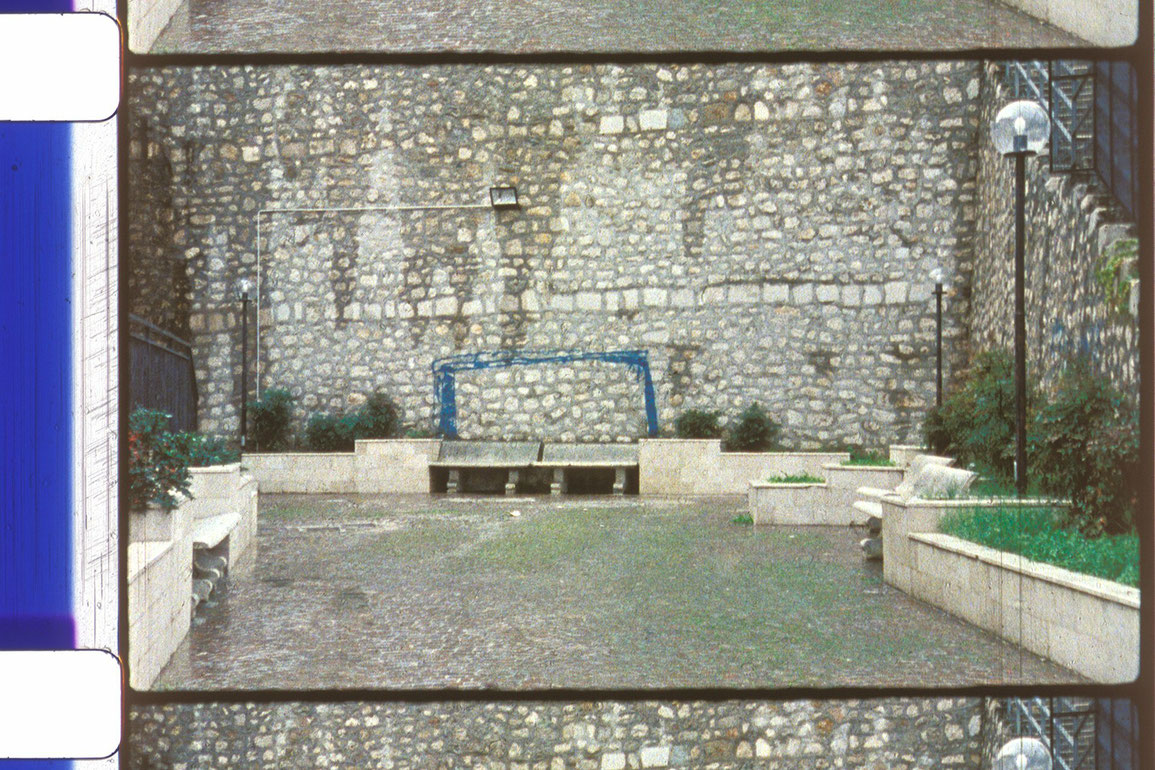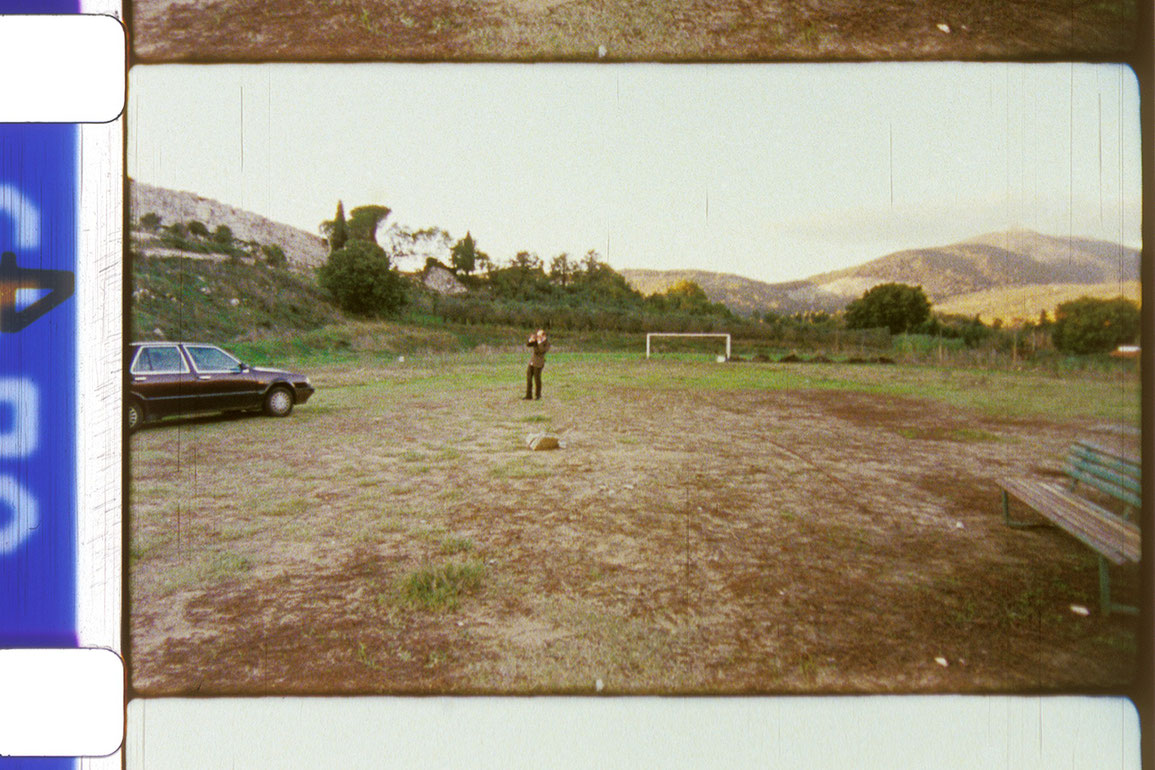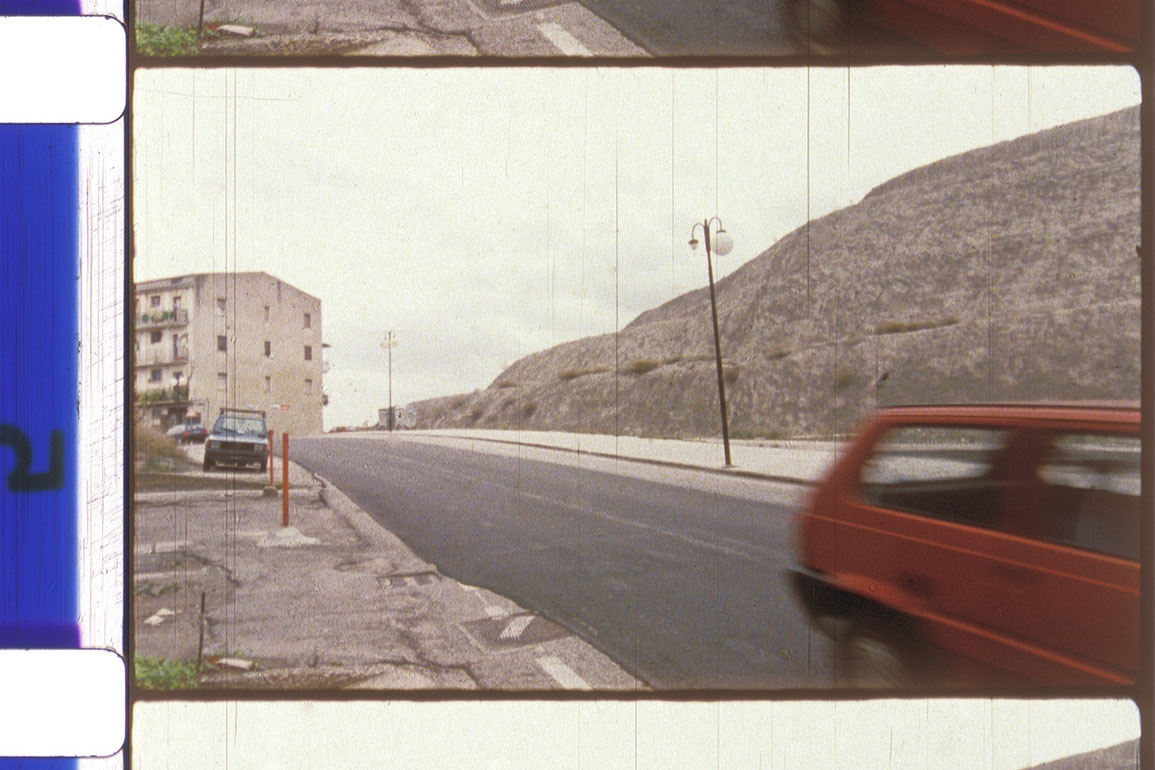Lancia Thema
"A journey by car into the no man´s land of the Garden of Eden" - Josef Dabernig uses this terse statement to describe his enigmatic short film Lancia Thema. Why enigmatic? Because we, the audience, as so often happens with the oeuvre of this filmmaker and visual artist, are made observers of episodes which do nothing to transport us into a "story", or even provide a solution in the form of a point or surprising turn of events. In the Dabernig universe "plot" signifies a period of time which we enter abruptly and leave in the same manner. Everything that happens follows systems of order, conforms to patterns which remain outside us. They are part of his characters, are derived from reasons that are never explained, and follow the pathways of the spaces they inhabit or pass through.
Lancia Thema is a film of a trip along unfamiliar landmarks and with an unusual destination. The close-mouthed protagonist (Dabernig himself) passes through a deteriorating Mediterranean countryside in the eponymous sedan, then stops suddenly, gets out and takes a picture of his car. Like the actions of the staff in "WARS", the driver´s movements (and the film´s as well) follow ritual patterns: The self-absorbed driving (accompanied by bel canto arias playing on the radio) always leads to a photo session, while the camera abandons man and car, turning its attention to the surrounding countryside in meticulous pans. The title´s simplicity (it makes no claim other than what actually happens) equals the complexity of the associations, ideas and images the film triggers: layers of time (in architecture and the musical references), culture (the Mezzogiorno and its history of political and cultural shifts) and, not least, photography and its dual existence between documentation and fantastic storytelling.
(Michael Loebenstein)
Dabernig plays a tourist driving through a damp, lush and kaleidoscopic landscape – in South-Lazio, Campania and Basilicata – listening to arias on his stereo as the viewer is treated to the astonishing splendor of the scenery. Suddenly, he pulls over by rock face and gets out of his Lancia, fumbles with his analog photo camera and begins photographing his car. The film´s gaze strays from protagonist and contemplates the painterly, awesome surroundings. This gesture is repeated several times between lengthy stretches of driving, which recall so many angstinduced European art films whose tension builds along highways.
autobahns and autostradas.
(Andréa Picard)
--> LANCIA THEMA
In a Matter of Time: Josef Dabernig by Andréa Picard for www.cinema-scope.com, Aug2006 (Article)
Dabernigs short films have concurrent themes and motifs, each recognizably, unmistakably his. A cross between Béla Tarr, Jacques Tati, Samuel Beckett, and Aki Kaurismäki, these works ranging in length between seven and 24 minutes rely on minimalism to fashion portraits of modernist decay and the banal scenarios that occur amidst their structures. As much about architecture and history in place as they are about the ridiculous inherent in ritualistic exchange (between people, landscape, technology), Dabernigs films exhort contradictions with every twist of road. A deadpan treatment of these existing and fabricated scenarios further distorts a definitive worldview, which, while puzzling, is alluringly bizarre and foreboding. The farcical elements, often physical, are laced with a dark, existential confusionnot only one which questions existence but every social interaction and prescribed decorum. A Monsieur Hulot-type character, played by Dabernig himself, often figures in the work, embarking on a set task which seemingly exists in a fully formed universe, but the audience is welcomed in perhaps mid-way through the endeavour (it is not clear). Much remains blurred in the work, but the repetition of imageryof cars, trains, desolate and decaying landscapes, abandoned buildings and semi-futuristic, socialist architecturesuggests an ongoing narrative whose structural expectations are all but abbreviated in any given film. Difficult to situate, Dabernigs films reside near the boundaries of both narrative and avant-garde filmmaking, resting unsure of eithers hypothetical position in todays art world.
Wisla (1996) begins with a large, blocky, concrete structure jutting into the composition, a modern ruin standing proud despite its neglect. The camera then pans insistently to the left, surveying tops of structures barely penetrating the frame composed of a big, grey sky. Shot in soft black and white, the film looks and feels old, itself an implied remnant from another time. Two men in suits and ties walk through the concrete catacombs of a dilapidated, brutalist football stadium, to the coachs bench, Wisla clearly labeled on the side of the glass structure where they settle and sit. This is the home of the famous Polish football team; off-screen sounds (Italian!) erupt as the game gets underway. Boisterous cheering and loudspeaker refereeing conjure the visuals of the match as the camera remains focused on the two men who are somewhat awkwardly playing out the clichés of a soccer coach and training assistant. Registering nervousness and frustration, their gestures are exaggerated and unrealistic. And yet, they are amusing, never maddening, nor nearly as unbelievable as the real thing. Dabernigs character gets up, calmly walks to the edge of the playing field and signals to his make-believe players, and the camera responds to his order by quickly panning up to reveal row upon row of empty seats. This game (the imaginary football match and the films precise sound-image play) continues for a few more minutes until the two men rise, walk up through the bleachers and greet dignitaries watching the game. A series of handshakes takes place, and the two Wisla members walk off-screen, the camera pulling out to expose the barren stadium. Wisla ends as the Italian football commentary continues through the credits, which appear at the end of all of Dabernigs films in a typewriter-like, anachronistic font. An introduction into Dabernigs self professed no-mans land, Wisla depicts the un-depicted, where familiarity is elided in exchange for the geometry of human-made interventions into the natural order.
Two years later, Dabernig co-directed Timau with German photographer Markus Scherer, a 20-minute, black-and-white, tripartite vignette which has been called a workers melodrama. The first shot reveals two men driving in a car through a beautiful, but treacherous, mountainous landscape, with lyrical lightplay being performed upon their cars windshield. The sleepy passenger shifts to reveal a third person in the backseatthe entire film, like all of Dabernigs, relies on a revelation-concealment structure. As they drive, we hear the distinctive but undetermined sounds of the car radio and see wondrous ruins like aquaducts and bridges from a distant era. Driving through tunnels, the passengers are alternatively obscured by darkness and obliterated from sunshine, this chiaroscuro peek-a-boo exchange acting as dramatic highpoint to the films uncertain storyline. Finally, they park next to a rock face that displays a mysterious rectangular delineation seemingly drawn with chalk, and fetch their gear from the trunk. As the tension for narrative builds, the second section of the film draws out the desire for story and refuses quick fulfillment. The three men, dressed in some kind of uniform, continue their journey on foot, lugging briefcases. The leader of the trio uses ski poles to help him climb the hilly, landscape. Timau adopts a silent film aura as they mount the brush ever upward, their steps unheard on the soundtrack, the quiet contradicting the arduousness of their hike. This oddly tranquil ascent seems to go on forever until eventually they reach a dark tunnel and the sound is restored. The light from the opening casts their plodding outlines in sharp contrast, and there is very little to see on screen except for shafts of light alternatively illuminating the top of their heads and then their feet. Laborious and claustrophobic, their trudging is enhanced through the sounds of heavy breathing. When they at last emerge into daylight again, the camera explores the jagged rock faces and catches a slithery snake as it cowers beneath a rock, this observational gaze belonging to none of the men.
The third section reveals what the three men have come to do, an uncanny denouement which is sealed through a formal pact (whose echoes will reappear later on at the end of Rosa Coeli, one of his best and most fascinating films). Deed done, wistful romantic music concludes this odd, elegant tale, the end of which I will not spoil. But its a typical Dabernig motif: the paradoxical coming together of old and new worlds. Unsurprisingly, his oeuvre has occasionally been read as a fabled Western excursion into the East; his camera and Hulot-esque character representing the European sophisticate (though awkward and misplaced) casting a peculiar look upon former Soviet states stuck in a time warp. While the aesthetic collision of rural and urban, and of traditional structures and modernist buildings recurs, the dividing line between old and new is not the dominant theme. Anything askew is.
Jogging (2000), for example, is wickedly strange. Again we begin in the car, this time in striking, saturated colour. Twentieth century orchestral music plays from the stereo as the car travels through a decrepit landscape marked only by unidentified communist architecture; the mood grows steadily eerie. The music, now haunting and gothic, grows louder as the camera voyeuristically glances through the sideview mirror, catching the reflection of buildings hovering in the background, compulsively observing the drivers hands, pausing on the dashboard, and looking out the windshield from the backseat. The editing grows quicker as the collage of bizarre imagery (drooling and barking wild dogs, a herd of goats) increases with the music, culminating in an all-consuming state of disquiet. The ultimate destination is Renzo Pianos UFO-inspired Stadio San Nicola, built for the 1990 World Cup. The car suddenly stops, and the Adidas-sporting driver (we never see his face) steps onto the pavement with his puffy black sneakers; the camera goes mad. Swirling out of control, the ethereal music still soaring, the camera finally rests upon the big blue sky as the film ends in a LEclisse extended finale shot, the doom of modernity hanging indeterminately in mid-air.
Two less successful works followed, Wars (2001) and automatic (2002), before Dabernigs most ambitious film, 2003s Rosa Coeli. (In between, Dabernig made a six-minute short, Parking, but I was unable to locate any information on it, let alone a screening copy.) Though sumptuously shot in pristine black and white, Wars is a bit goofy, with the service staff of a passenger train going through the motions with too much self-inflection, the props too perfectly positioned, and the end result stilted. The trademarks are all there: the unsigned landscape framed by a series of windows, the title of the film physically located in the spacethis time over a baggage compartment and on the back of the seats in the empty restaurant compartmentthe boredom and monotony, the rehearsal of motion and movement through time and space. Its not tossed off by any means (how could it be with gleaming, precise cinematography that reveals the train compartment as a work of lacquered art?), but it is minor. The same can be said of automatic. Made with the music group G.R.A.M., the film is a drum-and-bass, pulsing, automotive musical taking place in a ramshackle parking garage. A road movie that never sees the road, this pared down curio is oddly reminiscent of Kenneth Angers Scorpio Rising (1964), but the revved up homoeroticsm is here replaced by solitary and silly art-making. But the crafty interplay between diegetic and non-diegetic sound is remarkable, and reminds us of Dabernigs clever and intricate use of sound overall. Its not incidental that the car audio tape player (now virtually obsolete) figures so prominently in his worksthat, and the chugging of trains, like the rhythmic mechanized sound at the beginning of Rosa Coeli.
A man (Dabernig) sits on a train ostensibly reading a newspaper. German voiceover recites his private thoughts, a dense and poetic text written by Bruno Pellandrini which lasts the duration of the film. En route to a small Moravian town, his birthplace, to bury his recently deceased father, the protagonist conjures his past inside his head as he physically goes through the motions of settling the formalities over his fathers death. A rumination on childhood, tinged with regret, sorrow, and existential longing, the beauty of the text is rendered elegiac through the masterful compositions highlighting the wonders of the land. As the villages past and the ruining of its eponymous monastery, named the Celestial Rose (after which the wine of the region was christened), emerges through this internal monologue, the camera dissects this snowy, sleepy town, its feeble-bodied villagers, and the anachronisms of its interior design. Like Timau, the signing of a pact is the concluding gesture, but Rosa Coeli is imbued with the weight of psychological solitude, a Baudelairian recoil for which there can be little sense of accomplishment. A cloaked sense of irony surely lays hidden amidst this picaresque tale, but as its so different from Dabernigs other works, its difficult to detect.
The same cannot be said of his latest film, the magisterial-farcical Lancia Thema (2005), showing in the Wavelengths program at this years Toronto film festival. Once again at the helm of a car, Dabernig plays a tourist driving through a lush, damp and kaleidoscopic landscape (looking very much like the Garfagnana region of Italy), listening to arias on his stereo as we get to take in the astonishing splendour of the scenery. Suddenly, he pulls over by a rock face (the same one as in Timau) and gets out of his Lancia, fumbles with his still camera and begins photographing his car. As he does so, the films gaze strays from the protagonist and contemplates the painterly surroundings. This gesture is repeated several times over between long stretches of driving; its like the Euro version of The Brown Bunny (2003), with opera instead of Gordon Lightfoot. An omnipotent eye oversees the world, is conscious of its geometries, of what is present, absent and celestial. The arias emerge from the audio tape, but it is the landscape that really sings, metaphorically but also in an otherworldly displaythe enigmatic pull that figures in all of Dabernigs works cannot be contained or explained. Despite the recurring image of Dabernig in his films, an unseen presence looms larger, effectively reminding us that there is something greater than both time and matter. However daunting, this we must accept as modernitys grand narratives betray their promises.
(http://www.cinema-scope.com/cs28/col_picard_filmart.htm)
Lancia Thema (texte français)
« Un voyage en auto dans le no man's land du jardin d'Éden », c'est en ces termes concis que Josef Dabernig décrit son énigmatique court métrage Lancia Thema. Pourquoi énigmatique ? Parce que nous, public, comme si souvent dans l'uvre de ce réalisateur et plasticien, sommes transformés en observateurs d'épisodes qui refusent de se laisser convertir en « histoire » et même de trouver un dénouement sous la forme d'une pointe finale ou d'un retournement inattendu. « Action » signifie, dans l'univers de Dabernig, être partie prenante d'un processus temporel dans lequel on entre brutalement et dont on est exclu tout aussi soudainement ; ce qui se produit obéit à des systèmes ordonnés, suit des schémas dont nous sommes exclus. Ceux-ci appartiennent aux seuls personnages, découlent de motifs qui demeurent inexpliqués, empruntent les voies de l'espace que les personnages habitent ou traversent.
Lancia Thema est un film de voyage qui évolue le long de jalons inhabituels et vers un but arbitraire. Au volant de la limousine éponyme, le protagoniste taciturne (Dabernig lui-même) parcourt des paysages méditerranéens tombant en ruine, puis soudain s'arrête, descend et prend sa voiture en photo. Tout comme les gestes du personnel de Wars, le mouvement du conducteur (et du film en lui-même) est régi par des structures rituelles : le maniement distrait de la voiture (au rythme des arias de bel canto que distille la radio) aboutit regulièrement à une séance photo pendant laquelle la caméra s'éloigne de l'homme et de sa voiture pour balayer l'espace environnant au moyen de mouvements précis. Si le titre est fort simple (n'énonçant rien d'autre que le sujet du film), les associations, les idées et les images que le film suscite n'en sont que plus complexes : des strates temporelles (l'architecture, les références musicales) et culturelles (le Mezzogiorno et l'histoire de ses deséquilibres dans la culture et la politique), sans oublier la photographie et sa double vie entre témoignage documentaire et fabulation fantastique. (Michael Loebenstein)
Traduction: Françoise Guiguet
Lancia Thema
2005
Austria
17 min



